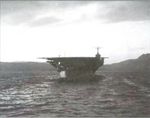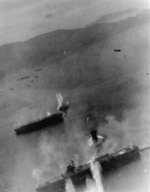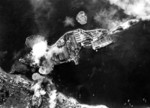Katsuragi
| Country | Japan |
| Ship Class | Unryu-class Aircraft Carrier |
| Builder | Kure Naval Arsenal |
| Ordered | 25 Jun 1942 |
| Laid Down | 15 Oct 1942 |
| Launched | 15 Oct 1943 |
| Commissioned | 3 Oct 1944 |
| Decommissioned | 1 Apr 1946 |
| Displacement | 22,534 tons standard; 22,800 tons full |
| Length | 745 feet |
| Beam | 72 feet |
| Draft | 25 feet |
| Machinery | Steam turbines, 8 boilers, 4 shafts |
| Power Output | 15,200 shaft horsepower |
| Speed | 34 knots |
| Range | 9,700nm at 18 knots |
| Crew | 1,595 |
| Armament | 6x127mm guns, 51x25mm AA guns |
| Armor | 1.8in machinery, 5.9in belt |
| Aircraft | 57 operational, 6 in reserve |
| Elevators | 2 |
Contributor: C. Peter Chen
ww2dbaseKatsuragi was completed near the end of WW2 when Japan had for the most part lost control of the seas, therefore she did not influence the outcome of the war in a significant manner. Her construction also reflected Japan's eventual fall. Her machinery was designed to use that of a cruiser's, but even with that, she had to be completed with destroyer turbines. The lack of steel meant she was not equipped with armored flight deck, like the rest of the carriers in her class, though since she was designed to be a convoy raider, armored flight deck was not completely necessary in the first place.
ww2dbaseBeginning in Feb 1945, after the aircraft originally assigned to her were re-assigned to land-based units, Captain Masaharu Kawabatu began to camouflage Katsuragi. Like other carriers, elaborate models were constructed on the flight deck to mask the fact that they were carriers. False buildings, painted streets, and real trees were set up on her flight deck. On 19 Mar 1945, Katsuragi came under attack by American aircraft from Task Force 58 while at Kure, Japan. She was hit by either a bomb or a 5-inch rocket on the starboard bow, blowing a 5-foot diameter hole, damaging the flight deck and upper hangar deck while killing one crewman. This was followed immediately by a second hit, likely to be a rocket, on the port side of the flight deck; the second hit caused little damage aside from a small hole. A near-miss by a dive bomber caused some flooding in the air compressor room and the Number 8 fuel tank. On 5 Apr 1945, some of her personnel were transferred to battleship Yamato, though for the remainder of the war, despite never deployed to sea again, she remained fully manned. On 24 Jul 1945, Kure harbor was once again attacked by American aircraft, this time by those of Task Force 38. Katsuragi escaped nearly unscathed, possibly due to the elaborate camouflage. She was attacked the final time on 28 Jul 1945 when the aircraft of Task Force 38 returned. She downed one American aircraft, but suffered a direct hit by a 2,000-pound bomb in the hangar. No fire broke out, but the entire upper hangar deck and both elevators were heavily damaged.
ww2dbaseAfter WW2, under the command of Captain Toshio Miyazaki who commanded her during the final four months of the war, Katsuragi was used as a repatriation vessel that transported Japanese troops back home. Damage caused by the 24 Jul 1945 was barely repaired as transport duties did not require her to have working elevators or a flat flight deck. Her post-war cruises took her to Minami Daito Jima, Rabaul, Australia, and other locations. After bringing home about 12,000 men from abroad, she was decommissioned at Kurihama, Japan in 1946 and scrapped in 1947 at Sakurajima Hitachi Zosen, Osaka, Japan.
ww2dbaseSources: Imperial Japanese Navy Page, Wikipedia.
Last Major Revision: Oct 2007
Aircraft Carrier Katsuragi Mapa Interativo
Photographs
 |  |  |  |
Katsuragi Operational Timeline
| 25 Jun 1942 | The order for carrier Katsuragi was issued. |
| 3 Oct 1944 | Katsuragi was commissioned into service. |
| 14 Jul 1945 | American battleships USS South Dakota, USS Indiana, and USS Massachusetts and escorting destroyers bombarded Kamaishi, Honshu, Japan; the primary target was the Kamaishi Works of the Japan Iron Company, but several destroyers shells overshot the target and hit the town, killing many civilians; battleship shells were more accurate, destroying about 65% of the industrial complex, but they also killed many civilians; this was the first time the Japanese home islands were subjected to naval bombardment. To the north, the sinking of 6 warships and 37 steamers on the ferry route between Honshu and Hokkaido islands effectively cut off the latter from the rest of the home islands. At Kure in southern Japan, aircraft of US Navy TF 38 damaged carrier Amagi, carrier Katsuragi, and battleship Haruna; at Misawa in northern Japan, G4M bombers that were assigned to partake the planned Operation Ken, which sought to deliver 300 suicide commandos to the Mariana Islands, were destroyed (the American would not know of Operation Ken until after the war). The carriers were escorted by a large naval force that included battleship USS Missouri. Far to the south, the USAAF XXI Bomber Command canceled a long-range P-51 raid from Iwo Jima to attack Meiji and Kagamigahara near Nagoya due to poor weather. |
| 28 Jul 1945 | 137 American P-47 aircraft based in Ie Shima, Okinawa, Japan attacked targest in Kyushu, Japan. On the same day, 471 B-29 bombers attacked smaller Japanese cities in the home islands with incendiary bombs. Finally, from the sea, US Navy carrier aircraft struck various Inland Sea ports between Nagoya and northern Kyushu, sinking battleship Haruna, battleship-carrier Ise, heavy cruiser Aoba (in shallow water), and light cruiser Oyodo, and damaging carrier Katsuragi, carrier Hosho, and already beached battleship Settsu. |
| 1 Apr 1946 | Katsuragi was decommissioned from service. |
Você gostou deste artigo ou achou este artigo útil? Se sim, considere nos apoiar no Patreon. Qualquer valor já vai ajudar! Obrigado. Por favor, ajude-nos a divulgar o site: Fique atualizado com WW2DB: |
Visitor Submitted Comments
All visitor submitted comments are opinions of those making the submissions and do not reflect views of WW2DB.

» Preparations for Invasion of Japan
Document(s):
» Japanese Aircraft Carrier Functions
» Japanese Aircraft Carrier Operational Status By Month
» Japanese Aircraft Carrier Specifications
» Japanese Aircraft Carrier Time Operational
Partner Sites Content:
» Katsuragi Tabular Record of Movement
- » 1,178 biografias
- » 337 eventos
- » 45,081 entradas na linha do tempo
- » 1,245 navios
- » 350 modelos de aeronaves
- » 207 modelos de veículos
- » 376 modelos de armas
- » 123 documentos históricos
- » 261 instalações
- » 470 eventos
- » 28,491 fotos
- » 365 mapas
Winston Churchill
Por favor, considere nos apoiar no Patreon. Mesmo R$1 por mês já faz uma grande diferença. Obrigado!
Ou, por favor, nos apoie adquirindo alguns produtos do WW2DB na TeeSpring. Obrigado!
19 Jan 2014 06:56:56 PM
Katsuragi was equipped with destroyer turbines with combined HP of 104,000, giving the ship a speed of 31-32 knots. Sisters with 152,000 HP Heavy Cruiser turbines (Soryu & Hiryu, and others) had 34 Knot Speed.